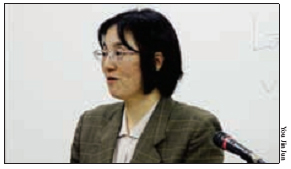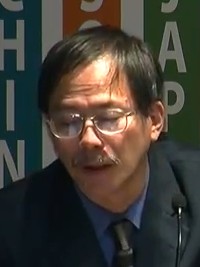
Centre of Jaina Studies Newsletter: SOAS - University of London
Jainism has been known to the Japanese for at least one thousand years. Before the Meiji era the understanding of it was only through Chinese Buddhist texts. Some of these Chinese texts refer to Niggaṇṭhanāta-putta Ṛṣabha and also offer some opinions of Jainism. Nichiren, founder of the Nichiren set of Buddhism in the 13th century, refers to Ṛṣabha as a heretical philosopher. So the interest in Jainism among the Japanese has a long history
Prior to the Second World War, some Japanese academics in Europe studied Jainism. Dr Ensho Kanakura (1896-1987) translated Jaina texts into Japanese. It was about twenty years ago that the late professor Astusi Uno, who had studied Jainism in Varanasi from 1954 through 1957, brought some Japanese students together to found the Society for Jaina Studies. Since then we have held an annual meeting at Otani University in Kyoto. In general, about 30 scholars participate and three papers are presented every year.
On the 4th of October 2008 more than 30 people from all over Japan, and also from Korea, attended the Jaina workshop at Otani University. Dr Moriichi Yamazaki, the third president of the society, inaugurated this year's meeting, followed by three stimulating papers and discussion.
Dr Akiko Shimizu, who recently completed her PhD at the University of London, spoke on the topic of her dissertation: The Community of Śvetāmbara Mūrtipūjakas in Delhi. According to the census conducted in 2001, the population of the Jains in Delhi is 155,122, which comprises 1.1% of the whole population of the city. There are more than 200 Jaina temples. Most of them belong to Digambara sects which are very powerful in the city and come from UP and MP. Mūrtipūjakas, whose ancestors came from Rajasthan or Gujarat, maintain 16 temples. Sixty-one meeting halls are kept by Sthānakavāsīs from Rajasthan or UP. As is well known, the Jains in Delhi mostly run retail or wholesale shops and some of them are jewelers.
Next Dr Shimizu explained the strata of the Jaina mendicant community among the Mūrtipūjakas. The broadest sub-categories are the gacchas, such as the Tapā, Vimala, Añcala and so on. Under the gaccha, a group led by an ācārya is known as samudāya. This is followed by parivāra, which is usually translated as 'family'. Dr. Shimizu pointed out that there is a tight relationship between mendicants and laypersons in the samudāya.



As an example of a typical Jaina community, Dr Shimizu described one in Rūp Nagar which is located in the northern part of Delhi. She defined a community as a group of laypersons that supports a particular assembly of mendicants and is based on a doctrine and rites.
Historically the Mūrtipūjakas in the Punjab were directly guided by Ācārya Vijaya Ānanda (1836-96) and Ācārya Vijaya Vallabha (1870-1954). After the partition, the Jains took refuge in Old Delhi, and in the middle of 1950 they settled at Rūp Nagar and Kamla Nagar. As a formal organization, Śrī Ātmānand Sabhā Rūp Nagar/ Delhi was founded, and in 1961 built Śrī Śāntinātha Jain Śvetāmbar Mandir Rūp Nagar. This Sabhā supports the Vallabha Samudāya to which 52 monks and 205 nuns belong. For the rites in a temple or at home they use a text compiled by the two ācāryas as a guidebook.
Since the attendees of the workshop had little knowledge of contemporary Jainism, Dr Shimizu's report was very stimulating indeed.
Dr Mi Suk Kim, the second speaker, got her PhD in Jaina Studies from Ton Gok University in Seoul. She is a professor at the university and a leading Korean scholar on Jainism. At our invitation, Dr Kim visited Japan with her students and gave a talk on Jaina Studies in Korea.
Koreans are famous as pious Buddhists, but according to Dr Kim, modern studies on Buddhism only started about 50 years ago. Jaina Studies are younger than that, and in the strict sense of the word, began just recently. So far, three PhD dissertations on Jainism have been submitted by Korean scholars. The dissertation by Dr Jim So Kim explained the relationship between Buddhism and Jainism in ancient India, and also discussed the theory of Ahiṃsā. Dr Hawon Ku, who had previously read a paper on Jainism at a workshop at SOAS, examined the history of Śatruñjaya in her dissertation as submitted to Minnesota University.
Dr Kim pointed out that the main feature of Jaina Studies in Korea can be summarized as follows: Firstly, Jaina Studies has a close relation with the Buddhist Studies; those who wrote papers on Jainism in the earlier period of Jaina studies in Korea mostly majored in Buddhism. They stopped pursuing Jaina Studies after publishing a few papers, those having been regarded as a sub-category of their Buddhist studies. Secondly, the Korean interest in Jainism, and the study of it, is aimed at utilizing the topic for a deeper understanding of Jaina vegetarianism, environmental issues, and ecology. Satish Kumar, who once took the initiation of Jainism, influenced Korean ecologists through his writings, which were introduced to Korea in 1997. Dr Kim concluded that the key to increasing the academic momentum of Jaina Studies in Korea is to translate the main scriptures and analyses of them. This would facilitate an understanding of Jainism as a unique religious system.
The final presentation, on Śīla-pāhuḍa attributed to Kundakunda, was given by Dr Kiyoaki Okuda, who is known in the western world for having edited and published the Digambara work Mūlācāra. In Japan he is one of the leading scholars of Jainism. In addition to presenting a Japanese translation of the work mentioned above, he also made some important suggestions. First he pointed out that the Digambaras were told to use Jaina Śaurasenī for their writing, but in fact they used Māhārāṣṭrī. His second suggestion was that the Digambaras compiled their fundamental texts by quoting verses from the older strata of the Āvaśyaka Niryukti. Dr Okuda also recommended that we should study the Jaina view of living beings as elucidated in the 36th chapter of the Uttarādhyāyana and in the Mūlācāra.
It was a very productive, stimulating meeting and we were grateful to the participants for their contribution to the study of Jainism in Japan and Korea. After the presentations, we held a general meeting of the society where information about the 14th World Sanskrit Conference in Kyoto was given. It is our hope for a continued expansion of the study of Jainism in our part of the world.
Sin Fujinaga is a professor at Miyakonojō Kōsen (Miyakonojō National College of Technology). His research centres on all aspects of Jainism.
 Dr. Shin Fujinaga
Dr. Shin Fujinaga